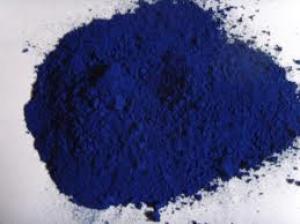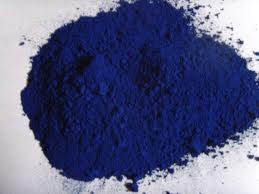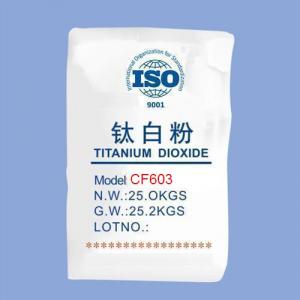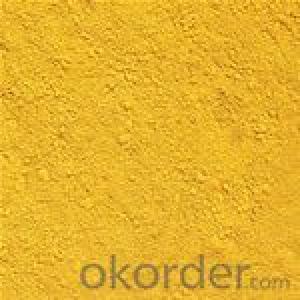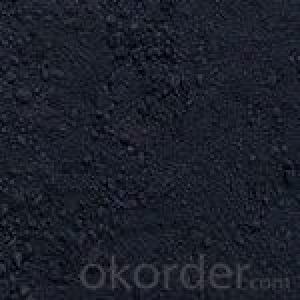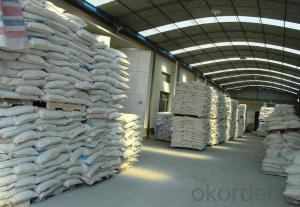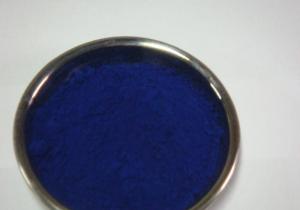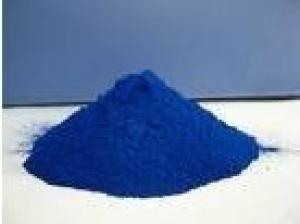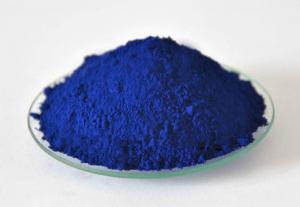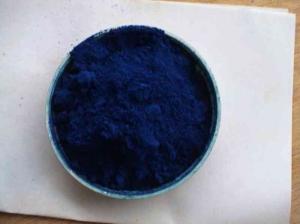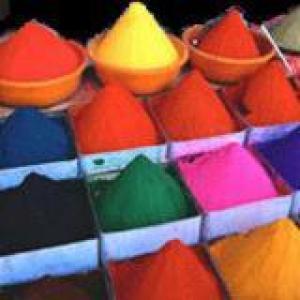Phthalocyanine Blue Pigment Blue 15:1 Manufacturer
- Loading Port:
- Tianjin Port
- Payment Terms:
- TT or LC
- Min Order Qty:
- 1 Metric Ton m.t.
- Supply Capability:
- 7,500MT/Year m.t./month
OKorder Service Pledge
OKorder Financial Service
You Might Also Like
Product Specification Of Phthalocyanine blue | |||
Chemical Structure | CuPc α | ||
Color Index No. | PB 15:1/74160 | ||
Application | Paint | ||
Physical Form | powder | ||
Test Items | Index | Test Method | |
Relative Tinting Strength | 100 +_5% | DIN55986 | |
ΔE,ΔL,Δa,Δb | ≤1,+1,+1,+1 | ||
Items | Index | Test Method | |
PH | 6.5~9 | DIN ISO 787-9 | |
Density 20℃ g/cm3 | 1.6 | DIN ISO 787-10 | |
BET m2/g | 72 | DIN 66131 | |
Oil absorption g/100g | 35~45 | DIN ISO 787-5 | |
105℃ Volatile Matter | ≤1.0% | DIN ISO 787-2 | |
Water Solubles | ≤1.5% | DIN ISO 787-13 | |
Residue on Sieve 100 mesh | ≤5% | DIN 53195 | |
Conductivity us/cm | ≤300 | DIN ISO 787-14 | |
Solvent Resistance | Index | Test Method | |
Water | 5 | DIN ISO 105-A03 | |
White Spirit | 5 | DIN ISO 105-A03 | |
Ethanol | 5 | DIN ISO 105-A03 | |
Acetone | 5 | DIN ISO 105-A03 | |
Dimethylbenzene | 4 | DIN ISO 105-A03 | |
Tolerance | |||
Light Fastness | Index | Test Method | |
Weather Resistance | 8 | DIN ISO 105-A03 | |
Acid Resistance | 5 | DIN ISO 105-A03 | |
Alkali Resistance | 5 | DIN ISO 105-A03 | |
5 | DIN ISO 105-A03 | ||
Application Of Phthalocyanine Blue :
Recommended for PE, Industrial paint, decorative paint, coil coating and textile printing.
Suggested for PVC, water based inks, OEM paint and powder coating.
Package Of Phthalocyanine Blue :
25 kg /kraft Bag or as your requirements .


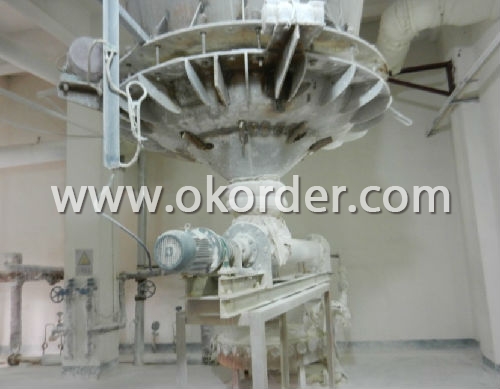
- Q: Are carontenoids and anythocyanin accesory pigments.
- Accessory pigments are those , that can not do photosynthesis and manufacture sugar as essential pigment chlorophyll does. But these accessory pigments capture solar energy in the form of photons and then transfer it to chlorophyll molecules / pigments . Thus increasing the power of chlorophyll to do photosynthesis . carontenoids and anythocyanin are accesory pigments. click on the links below to learn more about the accessory pigments - en.wikipedia.org/wiki/Accessory_p... www.ucmp.berkeley.edu/glossary/gl... www.cas.muohio.edu/~meicenrd/BMZ1... Thank you !
- Q: do all leaves extract contain the same pigments??why?
- Absolutely not. Leaf pigments, just to name a few, may include chlorophyll, carotenes, lutein, anthocyanins. Not only will pigment content vary between plant species, but pigment content will vary in individual plants seasonally.
- Q: Can you take any powder, grind it finely, and mix linseed oil into it to make oil paints to make paint? Or do paint pigments have to have special characteristics? Thanks!!
- Pigments are specific minerals found in rocks. Then they are ground down and mixed with the binders for oil, acrylic, and watercolor paints. You can take art classes that teach you how to make your own paints. I have a cousin who hikes to find her own pigments and makes all the colors she paint with. If you'd like something less labor-intensive, you can buy the pigments you want from lots of art stores these days. They can be added to pre-existing colors to enhance them, or you can start from scratch to formulate your own colors. The bottles i've seen are around 8 ounces, and cost about $50. You will likely find books in the library and articles online that will help you learn to make your own pigments.
- Q: are photosynthetic pigments separated based on their polarity or based on their molecular structure?Thanks
- Molecular structure... Chlorophylls are greenish pigments which contain a porphyrin ring. This is a stable ring-shaped molecule around which electrons are free to migrate. There are several kinds of chlorophyll, the most important being chlorophyll a. This is the molecule which makes photosynthesis possible, by passing its energized electrons on to molecules which will manufacture sugars. All plants, algae, and cyanobacteria which photosynthesize contain chlorophyll a. A second kind of chlorophyll is chlorophyll b, which occurs only in green algae and in the plants. A third form of chlorophyll which is common is (not surprisingly) called chlorophyll c, and is found only in the photosynthetic members of the Chromista as well as the dinoflagellates. The differences between the chlorophylls of these major groups was one of the first clues that they were not as closely related as previously thought. Carotenoids are usually red, orange, or yellow pigments, and include the familiar compound carotene, which gives carrots their color. These compounds are composed of two small six-carbon rings connected by a chain of carbon atoms. As a result, they do not dissolve in water, and must be attached to membranes within the cell. Carotenoids cannot transfer sunlight energy directly to the photosynthetic pathway, but must pass their absorbed energy to chlorophyll. For this reason, they are called accessory pigments. One very visible accessory pigment is fucoxanthin the brown pigment which colors kelps and other brown algae as well as the diatoms.
- Q: My wife went to the eye doctor to get new glasses (because she couldn't renew her driver's license with her glasses she had been using), and the doctor said that she wasquot;losing pigment" in both of her eyes. He said not to worry, but he wants her to make an appointment every 6 months, instead of just once a year.What does it (her losing pigment in her eyes) mean? Is it really nothing to worry about?(My wife doesn't seem worried, she hates going to doctor's but she trusts them when she goes to them; she doesn't ask questions-- she feels that if she needed to know something the doctor would tell her.)
- Yes, pigment is what gives your eyes color like Insanity said. It has nothing to do with the cornea becoming cloudy or going blind. In fact, it shouldn't affect her vision at all. The reason that the doctor wants to see her often is probably because as the pigment comes off the iris, it flows through the ocular fluid. This fluid follows a certain course through the eye and leaves through something called the trabecular meshwork, kind of like a filter or strainer. The pigment can block this meshwork, causing the pressure in the eye to increase, which can damage the eye. The pigment would have to build up before this happened, though, so don't worry about this happening over night or something. As long as the doctor is checking up on her, I'm sure she will be fine, so make sure she goes in for those checkups. For more information, look up Pigment Dispersion Syndrome.
- Q: whats it for? lol
- itz for ur beautifing ur skin.
- Q: How are plant pigments like teammates on a sports team? And What is the goal of their teamwork??
- WELL to be exact cuvette 2: to observe the role of photosynthesis with chromatin cuvette 3: to observe the role of photosynthesis with UV rays cuvette 4: to observe the stability of the chloroplasts cuvette 5: to observe the reaction of the H2O synthesis
- Q: how exactly do pigments work? i know that they absorb every color except the one that we see, but what are the exact physics or whatever behind the selective absorption of the light?
- Different pigments mostly absorb different range at different wavelength of light, but plant -as I know- mostly containing chlorophyll does not absorb green light so we see plants as green.
- Q: light absorption, which pigments are involved?
- All photosynthetic organisms contain one or more organic pigments capable of absorbing visible radiation, which will initiate the photochemical reactions of photosynthesis. The three major classes of pigments found in plants and algae are the chlorophylls, the carotenoids and the phycobilins. Carotenoids and phycobilins are called accessory pigments since the quanta (packets of light) absorbed by these pigments can be transferred to chlorophyll. Chlorophylls chlorophyll a - present in all higher plants and algae chlorophyll b - present in all higher plants and green algae chlorophyll c - diatoms and brown algae chlorophyll d - red algae (chlorophyll a is present in all photosynthetic organisms that evolve O2.) Chlorophyll molecules contain a porphyrin 'head' and a phytol 'tail'. The polar (water-soluble) head is made up of a tetrapyrrole ring and a magnesium ion complexed with the nitrogen atoms of the ring. The phytol tail extends into the lipid layer of the thylakoid membrane. Carotenoids (carotenes and xanthophylls) Carotenes: -carotene - higher plants and most algae $-carotene - most plants some algae xanthophylls: luteol, fucoxanthol and violaxanthol Carotenoids contain a conjugated double bond system of the polyene type (C-C=C-C=C). Energy absorbed by carotenoids may be transferred to chlorophyll a for photosynthesis. Phycobilins (found mostly in red and blur-green algae): phycoerythrin phycocyanin allophycocyanin )
- Q: What happens to the yellow pigments in a leaf during the summer months?
- in case you may surely ask a query like that, then it sounds to me such as you opt to have intercourse with one in all your instructors. enable me be the 1st to tell you that it will no longer take place! She's/he's have been given a husband/spouse to do each and all the grimy paintings for her/him! you're basically a pupil and that's a criminal offense in each and each state for a instructor to have something for a minor! Have had a weigh down on a instructor, definite that's a load of bull-****, yet that's the way life is and we the two might desire to provide up dreaming and locate ourselves a hoe which will please us in each way conceivable! that's effective to appreciate that somebody else has wandered that. % me as suited answer on account which you and that i've got lots in worry-loose!
1. Manufacturer Overview
| Location | Henan, China |
| Year Established | 1995 |
| Annual Output Value | Above US$100 Million |
| Main Markets | 20.00% North America 20.00% South America 10.00% Eastern Europe 10.00% Southeast Asia 10.00% Northern Europe 10.00% South Asia 10.00% Western Europe 5.00% Africa 5.00% Mid East |
| Company Certifications | REACH, ROSH,SVHC 53 Items Certificate ,SGS,CIQ,ISO9001:2008 |
2. Manufacturer Certificates
| a) Certification Name | |
| Range | |
| Reference | |
| Validity Period |
3. Manufacturer Capability
| a) Trade Capacity | |
| Nearest Port | Qingdao Port, China |
| Export Percentage | 51% - 60% |
| No.of Employees in Trade Department | 100 People |
| Language Spoken: | English; Chinese;Spainsh; Farsi;French;German |
| b) Factory Information | |
| Factory Size: | Above 600,000 square meters |
| No. of Production Lines | Above 3 |
| Contract Manufacturing | Design Service Offered; Buyer Label Offered |
| Product Price Range | Rock Bottom Price With Best Quality |
Send your message to us
Phthalocyanine Blue Pigment Blue 15:1 Manufacturer
- Loading Port:
- Tianjin Port
- Payment Terms:
- TT or LC
- Min Order Qty:
- 1 Metric Ton m.t.
- Supply Capability:
- 7,500MT/Year m.t./month
OKorder Service Pledge
OKorder Financial Service
Similar products
Hot products
Hot Searches
Related keywords
